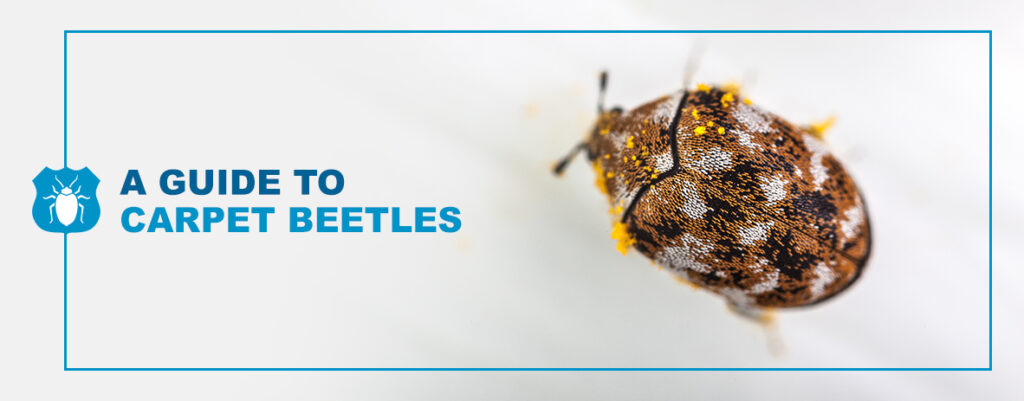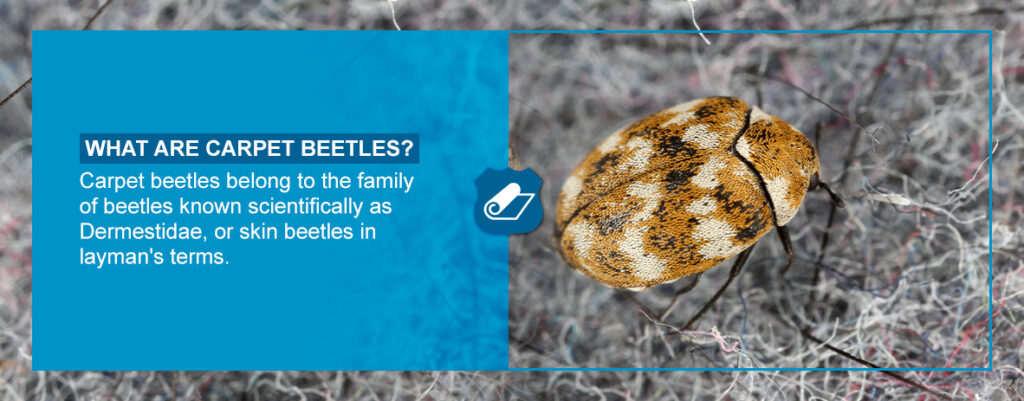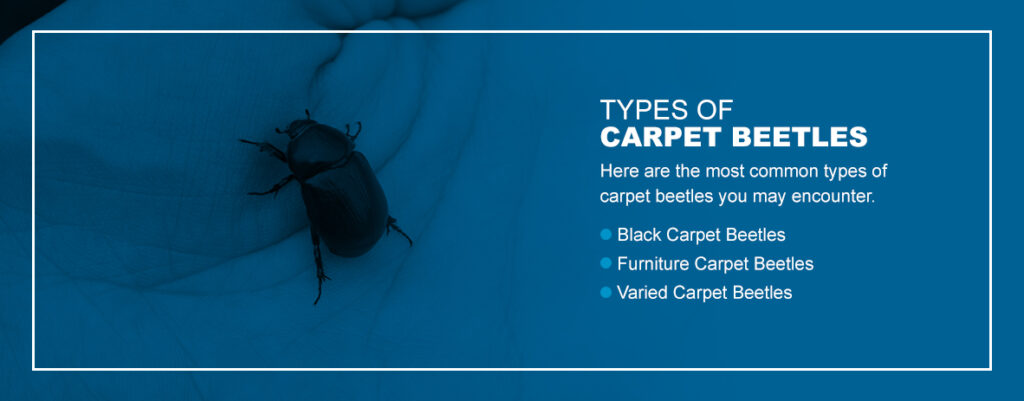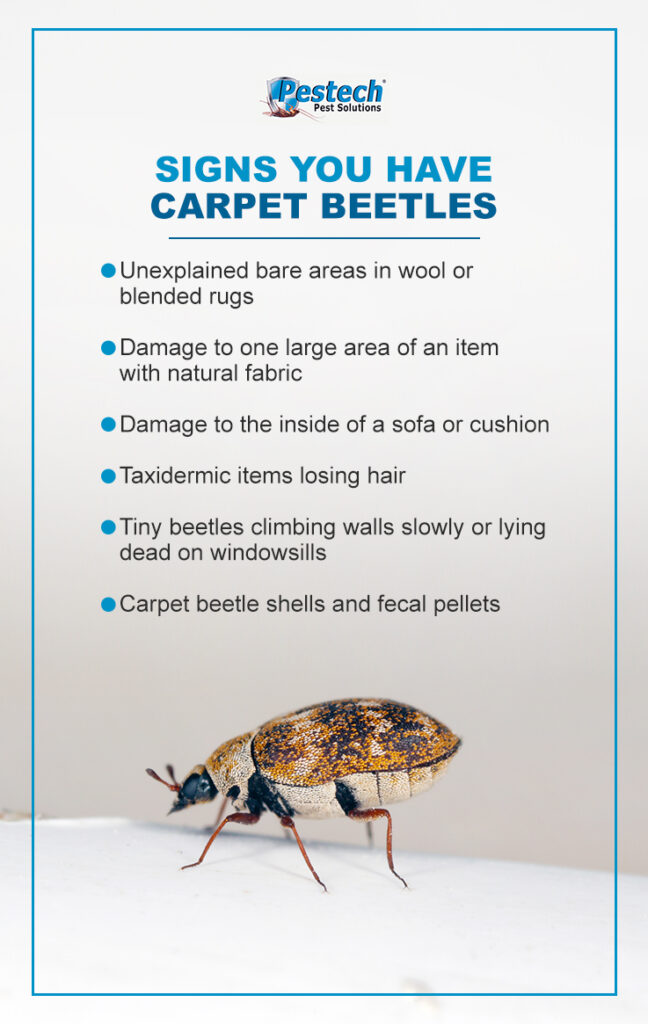A Guide to Carpet Beetles

Whether you are fond of our insect friends or grimace whenever you see one, carpet beetles are a foe through and through. In this guide to carpet beetles, we explain all you need to know about these little critters, including why you should protect your home or workspace from them and what you can do to get rid of them.

What Are Carpet Beetles?
Carpet beetles belong to the family of beetles known scientifically as Dermestidae, or skin beetles in layman’s terms. As a type of skin beetle, carpet beetles feed on dry animal carcasses and products. Although they naturally congregate outdoors, they are a common domestic pest, often wreaking havoc in homes, museums, warehouses and any space that provides a food source.
Why Are They Called Carpet Beetles?
Carpet beetles receive their name from their tendency to infest carpets. Although they prefer to hide out in dark, damp areas, they also lay their eggs in areas dense with natural fabric since that is what larvae typically feed on. As such, carpets often serve as an ideal breeding ground for carpet beetles, as long as the carpet is natural and not synthetic.

Types of Carpet Beetles
Here are the most common types of carpet beetles you may encounter.
Black Carpet Beetles
Black carpet beetles (Attagenus unicolor) are the most common type of carpet beetle in New York and the surrounding states, as they are not as well-suited to warmer temperatures as other types of carpet beetles. As you may assume from their name, they have a shiny black shell with dark brown legs.
They are also the most destructive carpet beetle, eating large and irregular holes through any natural fabric. While adult black carpet beetles mostly stick to nectar and pollen as their meal of choice, the larvae will devour any animal product, including fur, wool, leather, hair, dead insects and dried meat. Occasionally, the black carpet beetle will also infest food sources like rice, grain, seeds and cereals.
Furniture Carpet Beetles
Compared with black carpet beetles, furniture carpet beetles (Anthrenus flavipes) tend to populate in southern regions with warmer temperatures. However, they can also thrive in any indoor space with adequate heating. They get their name from their tendency to feed on natural furniture fabric like feathers, padding and upholstery. The larvae also enjoy munching on carpet, fur, silk, cotton, horns, linen and twine.
Varied Carpet Beetles
Varied carpet beetles (Anthrenus verbasci) are more common in warmer temperatures than in northern, cooler states. However, like furniture carpet beetles, they commonly populate in warm, indoor spaces. They get their name from their variety of colors — white, brown, yellow, orange and black. In their larval stage, they are known as woolly bears because they are covered with dense tufts of hair.
Life Cycle of Carpet Beetles
The life cycle of carpet beetles occurs in four stages. The lengths of those stages vary with each type of carpet beetle. Since they are skin beetles, their life cycle involves complete metamorphosis. Like butterflies, though less aesthetically pleasing, carpet beetles’ initial state looks completely different from their final form. The four stages of complete metamorphosis are egg, larva, pupa and adult.
Black Carpet Beetle Life Cycle
The life span of a black carpet beetle is between one and two years, from the beginning of the egg stage to the end of the adult stage. If being the most destructive and most common type of carpet beetle wasn’t enough, black carpet beetles also lay the most eggs of any carpet beetle at approximately 90 eggs per breeding cycle.
After the eggs hatch within six to 16 days, the larva stage begins and goes on for 166 to 330 days. The pupation stage, during which the larva morphs into an adult carpet beetle, lasts between eight to 14 days. Once the transformation is complete, an adult black carpet beetle spends four to eight weeks eating nectar and pollen and laying eggs.
Furniture Carpet Beetle Life Cycle
Furniture carpet beetles live significantly shorter lives than black carpet beetles. They’re lucky if they make it past the first year. They also lay fewer eggs at approximately 60 eggs per breeding cycle. The egg stage lasts nine to 16 days, and the larvae grow up fast, eating furniture for 70 to 94 days until they enter the pupation stage. However, their adult life span is comparable to black carpet beetles at four to eight weeks.
Varied Carpet Beetle Life Cycle
In contrast with furniture carpet beetles, varied carpet beetles have a drawn-out larva life span. Like someone who refuses to move out of their parent’s basement and transition into proper adulthood, varied carpet beetle larvae are satisfied to linger on the couch, snacking their youthful days away. Consequently, their average life span is often as long as two years.
Varied carpet beetles lay approximately 40 eggs during their breeding cycle, which typically hatch within 10 to 20 days. They live as larvae for 220 to 630 days and pupate for 10 to 13 days. Female varied carpet beetles live longer than males on average. Whereas male varied carpet beetles live as adults for two to four weeks, females live for two to six weeks.
Dangers of Carpet Beetles
Carpet beetles can damage your belongings and cause health concerns.
Furniture, Fabrics, Clothes and Carpets
The primary danger that carpet beetles pose is to your furniture, drapes, clothing, carpets and any material in your home or workplace derived from natural sources. The threat is significant, too, as they can render couches, clothes and other expensive fabrics unusable or an aesthetic nightmare. Since adult carpet beetles do not feed on natural fibers, most damage occurs during the larval stage. They can also damage the felts and hammers in pianos if left uncontrolled.
Rashes, Infections and Allergic Reactions
Carpet beetles do not pose significant threats to your health. However, they can trigger an allergic reaction if they contact your skin, causing a bumpy and itchy rash known as carpet beetle dermatitis. If the allergens become airborne, they can also cause eye or respiratory irritations.

Signs You Have Carpet Beetles
Watch for these signs that you could have carpet beetles:
- Unexplained bare areas in wool or blended rugs: As an animal product, wool is of particular interest to carpet beetles.
- Damage to one large area of an item with natural fabric: Unlike clothes moths, which create scattered holes and damage to the fabric, carpet beetles focus on a specific area of their food sources that gradually gets larger.
- Damage to the inside of a sofa or cushion: You are unlikely to see carpet beetle larvae crawling around the surface of a sofa or other highly visible item. As such, considerable damage inside or underneath a sofa, cushion or similar item could signify carpet beetles.
- Taxidermic items losing hair: A taxidermic item is like a five-star meal to a carpet beetle. Hence, unexplained fur missing from a taxidermic item in concentrated areas is a telltale sign of carpet beetle infestations.
- Tiny beetles climbing walls slowly or lying dead on windowsills: Carpet beetles are tiny, so they move like molasses. They are also attracted to sunlight and are often spotted near windows and on curtains.
- Carpet beetle shells and fecal pellets: Carpet beetles shed and molt as they grow throughout their life cycle, so keep an eye out for evidence of molted shells and fecal pellets.
How to Get Rid of Carpet Beetles
If you have a carpet beetle infestation, the best solution is to call a professional pest control service. It can be incredibly difficult to get rid of carpet beetles on your own because they love to hide in those obscure, nitty-gritty areas where people seldom look. They also multiply like their mission is to take over the earth, or at least fill whatever space they happen to occupy.
The best action is to take steps to prevent carpet beetle infestations and limit their spread if they have already invaded your space.
Inspect Potential Problem Areas
Outside, inspect your foundation, looking for cracks that carpet beetles could enter through. Carpet beetles are tiny, so you’ll want to seal any cracks larger than about 1/8 inch.
Inside, examine furniture, clothes, carpets and any taxidermy for unexplained holes or signs of damage in a concentrated area. Check dark areas like in between cushions, underneath mattresses or closets where carpet beetle larvae are likely to congregate.
Dust and Vacuum Regularly
If you have pets that shed, this tip is essential to follow, as carpet beetle larvae are attracted to their hair. Use a strong suction vacuum and frequently dust areas you cannot easily vacuum. Make sure you get to those hard-to-reach areas, too, such as beneath heavy furniture, in between the cracks of tiles or behind the fridge, as those are the areas where carpet beetle larvae will reside.
Dry Clean Your Clothes and Steam Clean Furniture and Drapery
Although you don’t need to dry clean all of your clothes all of the time to prevent or get rid of carpet beetles, you may want to periodically dry clean clothing items you especially do not want damaged, particularly if you are already concerned that you might have a carpet beetle infestation.
Additionally, regularly clean drapery, furniture, carpets, taxidermy and other items containing natural fabrics. Steam cleaning works best, so try to use that method whenever you can.
Use Synthetic Fabrics
One effective solution to preventing carpet beetle infestations is to use synthetic fabrics instead of natural fabrics as much as possible. Since synthetic fabrics do not contain material from animal products, it is unlikely that carpet beetles would consider them a suitable source of food or place to lay their eggs.
Carpet Beetle FAQs
If you still have questions about carpet beetles, here are the answers to some frequently asked questions.
Where Do Carpet Beetles Come From?
Since adult carpet beetles enjoy a tasty meal of nectar and pollen, they are drawn to flowers. Consequently, they often enter homes, museums and workspaces on the petals of flowers brought inside to decorate the space. Since they can fly, they can also enter indoor spaces through open windows or cracks, gaps and holes in the foundation or walls.
What Do Carpet Beetles Look Like?
Each type of carpet beetle has a unique appearance. Moreover, since they go through complete metamorphosis, the larvae of each type are also unique and distinctly different from the adults. They range from 1/10 of an inch to 5/16 inches long, and the larvae are often longer than adults. For reference, a U.S. dime is ¾ of an inch in diameter.
- Black carpet beetle: As mentioned, an adult black carpet beetle has a shiny black and dark brown back with brownish legs. They range from 1/8 to 3/16 inch long and are oval in shape. In contrast, the larvae are light brown to black, can be as long as 5/16 of an inch and are much longer than they are wide.
- Furniture carpet beetle: Furniture carpet beetles range from 1/10 to 1/7 inch long as adults. They have a white underside and a black exterior with a mottled look of yellow and white. They also have a more distinct oval shape than black carpet beetles. The dark red to chestnut brown larvae are broad in the front, narrow in the rear and are approximately 1/5 inch long.
- Varied carpet beetle: As adults, varied carpet beetles are approximately 1/10 of an inch in length. Their wing covers are black and have irregular patterns of brown, dark yellow, orange and white scales. As mentioned, the larvae are covered in tufts of hair of alternating light brown and dark brown stripes that plume when disturbed. Like furniture carpet beetle larvae, they are also 1/5 inch long. Unlike furniture carpet beetle larvae, they are broad in the rear and narrow in the front.
- Carpet beetle eggs: Carpet beetle eggs are typically white or off-white and approximately the size of a grain of sand.
Do Carpet Beetles Bite?
Carpet beetles do not bite. However, the rashes and bumps caused when your skin contacts a carpet beetle larvae abdomen or hair can resemble bug bites. As noted above, such bumps and rashes more likely result from an allergic reaction to the carpet beetle fibers than a bite.
Call Pestech to Handle Your Carpet Beetle Problem
Attempting to get rid of carpet beetles on your own is a risky endeavor. Even if you have initial success at clearing the infestation, it could return just as quickly as carpet beetles are easy to miss and hard to eliminate. At Pestech Pest Solutions, we will put our pest control expertise to the test and do everything we can to eliminate your carpet beetle problem both now and in the future.
Our 100% guarantee means we continue to provide pest control services at no additional charge until we solve the problem to your satisfaction. Schedule an inspection online today or reach out to learn more about our carpet beetle pest control services.

